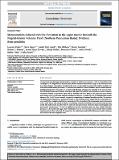Por favor, use este identificador para citar o enlazar a este item:
http://hdl.handle.net/10261/205732COMPARTIR / EXPORTAR:
 SHARE SHARE
 CORE
BASE CORE
BASE
|
|
| Visualizar otros formatos: MARC | Dublin Core | RDF | ORE | MODS | METS | DIDL | DATACITE | |

| Título: | Metasomatism-induced wehrlite formation in the upper mantle beneath the Nógrád-Gömör Volcanic Field (Northern Pannonian Basin): Evidence from xenoliths |
Autor: | Patkó, L; Liptai, N.; Aradi, László Elöd; Klébesz, Rita; Sendula, Eszter; Bodnar, Robert J.; Kovács, I. J.; Hidas, Károly CSIC ORCID; Cesare, Bernardo; Novák, Attila; Balázs, Trásy; Szabó, C. | Palabras clave: | Xenoliths Metasomatism Silicate |
Fecha de publicación: | 1-oct-2019 | Editor: | Elsevier BV | Citación: | Geoscience Frontiers 11 (3): 943-964 (2020) | Resumen: | Clinopyroxene-enriched upper mantle xenoliths classified as wehrlites are common (~20% of all xenoliths) in the central part of the Nógrád-Gömör Volcanic Field (NGVF), situated in the northern margin of the Pannonian Basin in northern Hungary and southern Slovakia. In this study, we thoroughly investigated 12 wehrlite xenoliths, two from each wehrlite-bearing occurrence, to determine the conditions of their formation. Specific textural features, including clinopyroxene-rich patches in an olivine-rich lithology, orthopyroxene remnants in the cores of newly-formed clinopyroxenes and vermicular spinel forms all suggest that wehrlites were formed as a result of intensive interaction between a metasomatic agent and the peridotite wall rock. Based on the major and trace element geochemistry of the rock-forming minerals, significant enrichment in basaltic (Fe, Mn, Ti) and high field strength elements (Nb, Ta, Hf, Zr) was observed, compared to compositions of common lherzolite xenoliths. The presence of orthopyroxene remnants and geochemical trends in rock-forming minerals suggest that the metasomatic process ceased before complete wehrlitization was achieved. The composition of the metasomatic agent is interpreted to be a mafic silicate melt, which was further confirmed by numerical modelling of trace elements using the plate model. The model results also show that the melt/rock ratio played a key role in the degree of petrographic and geochemical transformation. The lack of equilibrium and the conclusions drawn by using variable lherzolitic precursors in the model both suggest that wehrlitization was the last event that occurred shortly before xenolith entrainment in the host mafic melt. We suggest that the wehrlitization and the Plio–Pleistocene basaltic volcanism are related to the same magmatic event. | Versión del editor: | http://dx.doi.org/10.1016/j.gsf.2019.09.012 | URI: | http://hdl.handle.net/10261/205732 | DOI: | 10.1016/j.gsf.2019.09.012 | Identificadores: | doi: 10.1016/j.gsf.2019.09.012 issn: 1674-9871 |
| Aparece en las colecciones: | (IACT) Artículos |
Ficheros en este ítem:
| Fichero | Descripción | Tamaño | Formato | |
|---|---|---|---|---|
| Geoscience FRontier 2019 09 012.pdf | 6,37 MB | Adobe PDF |  Visualizar/Abrir |
CORE Recommender
SCOPUSTM
Citations
20
checked on 18-abr-2024
WEB OF SCIENCETM
Citations
18
checked on 23-feb-2024
Page view(s)
127
checked on 28-abr-2024
Download(s)
148
checked on 28-abr-2024
Google ScholarTM
Check
Altmetric
Altmetric
Este item está licenciado bajo una Licencia Creative Commons

